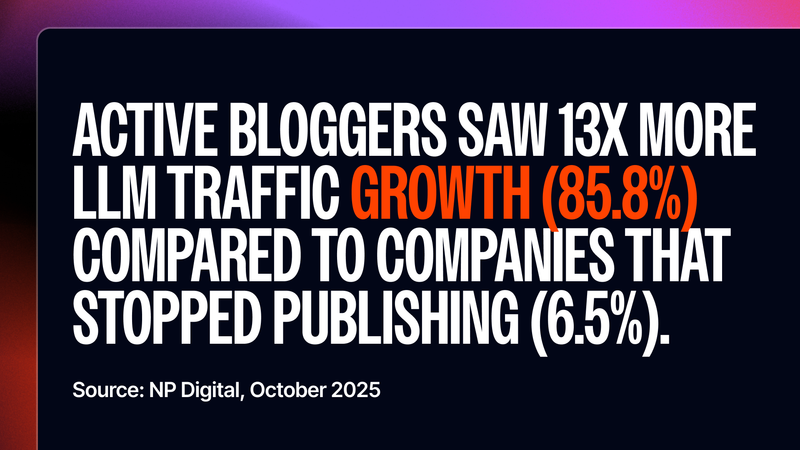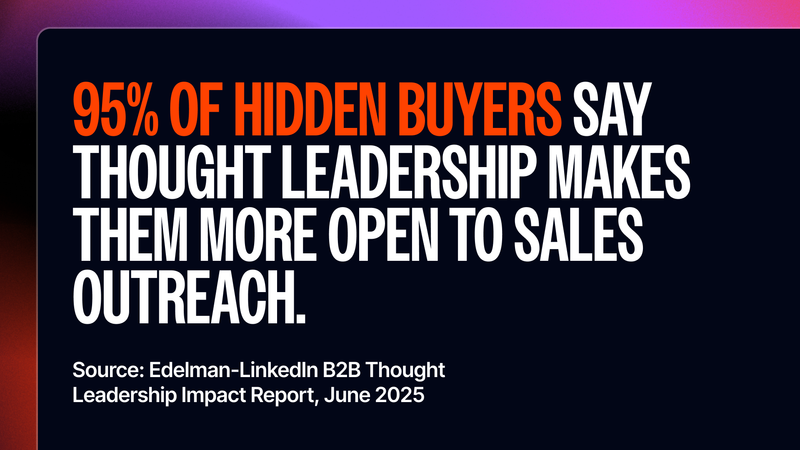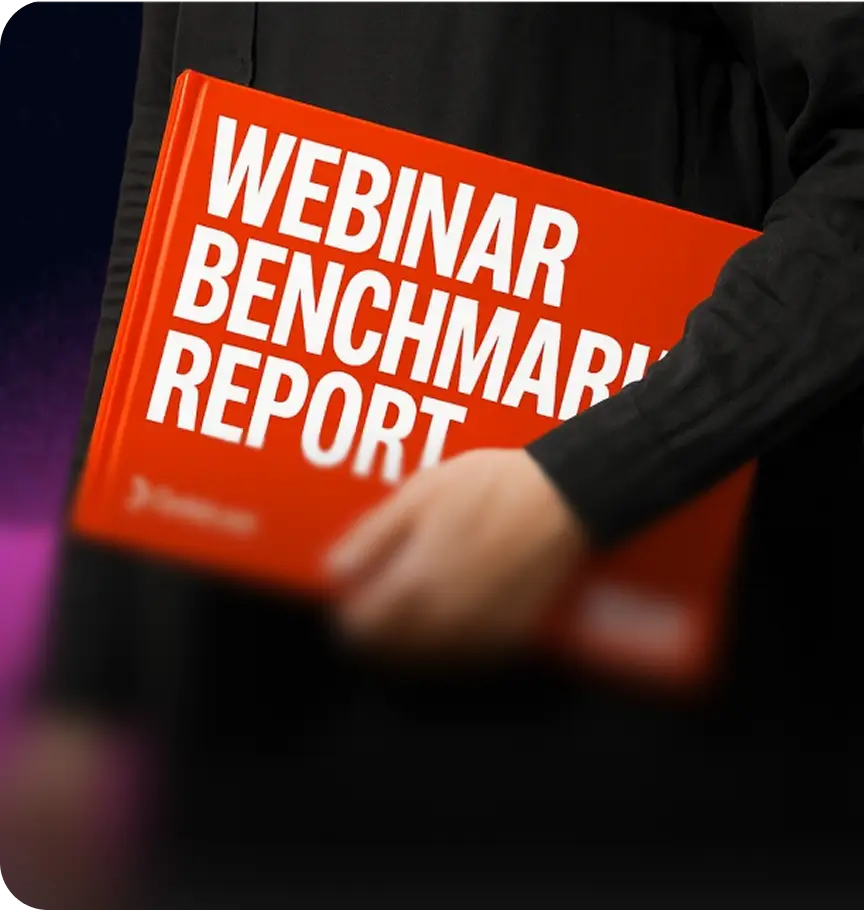How to Turn Your B2B Blog Into a Revenue Engine

Table of Contents
- Forget the shiny content calendar, start where you are
- Make your blog measurable
- The foundation of a high-performing B2B blog strategy
- Short-term wins vs. long-term blog strategy
- Content amplification and distribution
- Common blogging pitfalls to avoid
- Measure what matters: From mindshare to pipeline
- Elevate your B2B blogging with a video-first approach
- The future of B2B blogging: From articles to ecosystem
Maximize Your Marketing ROI
Join 10,000 other marketers already getting the best tips on running engaging events that boost pipeline and create raving fans.
B2B blogging isn't just about publishing articles. It's about building a content engine that drives real business outcomes. Data shows that companies that blog consistently generate 55% more website visitors than those that don't. But traffic alone doesn't pay the bills.
The most effective B2B blogs go beyond SEO to support a full-funnel experience backed by measurable results. All you need is a clear strategy for creation, amplification, and measurement.
In this guide, we’ll share practical tips to transform your B2B blog from a content repository no one cares about into a pipeline-generating machine that builds on its own success.
The highlights:
- Stop chasing pageviews; build a blog that maps to revenue.
- Align posts to one business goal, solve real buyer problems, and cover every stage of the journey.
- Balance quick wins (refreshes, better CTAs, clips) with consistent publishing
- Use AI to repurpose video and transcripts, but keep a clear POV and real examples
- Distribute intentionally and connect engagement data to your CRM
- Video-first= capture once, repurpose everywhere, measure what moves deals.
Ready to drop the sporadic publishing and keyword stuffing? Let’s get started.
Forget the shiny content calendar, start where you are
No matter how many times you revamp that content calendar template, your B2B blog still has the same problems:
- Posts are published irregularly and with zero strategy
- Content stays stuck at the awareness stage
- Outcomes stop at vanity metrics (hurray, more page views and traffic!)
Without a documented strategy, content is inconsistent and off-message. (And don’t even get us started on all those promotional puff pieces and SEO garbage. 🙅🏻)
If your blog feels disconnected from pipeline, you’re not alone. Data from the latest Demand Generation Benchmark Survey shows that marketers are prioritizing quality leads over volume. The golden days of ‘leads by any means’ are over. For quality leads at scale, your blog program should be need-meeting and revenue-focused.
If you already have a blog, audit your content to identify what is and isn’t working:
- Topics that consistently drive content engagement
- Preferred reader formats (research, how tos, examples & use cases)
- Content gaps in your buyer's journey
- Low-performing posts in need of updates
- Competitor content and opportunities to outperform
Starting fresh? Apply the same mindset to your existing content. Which webinars, newsletters, and LinkedIn articles get the most engagement? Which types of content reliably drive traffic from organic channels and social media?
With Content Lab, AI hunts through your video archive to find the moments worth blogging about. That’s free fuel for faster, better content creation.
Make your blog measurable
Begin with the end in mind. A high-performing marketing blog isn’t about rankings; it’s about building a system that ties content to specific business goals. Instead of blindly tracking pageviews, look for signals that indicate real business impact:
- Branded search lift
- Direct traffic lift
- Earned mentions and share of voice
- Time spent on high-intent pages (think pricing, demos, and implementation)
- Growth in organic traffic to strategic posts
- Content downloads
- Overall lead quality and velocity
- Sales conversations influenced
- Pipeline generated
With the right set of metrics, you can tie your content engagement data directly to CRM insights and start turning demand into revenue. Define KPIs for awareness, engagement, and lead generation so you can compare apples to apples across digital marketing channels, like email marketing and social media.
The foundation of a high-performing B2B blog strategy
Think of your blog as a hub of thought leadership — not a dumping ground for press releases and event recaps. With the right framework, it can amplify every other part of your content ecosystem. In other words, your B2B content marketing hub lives here.
Here are the three core steps to set (or reset) your strategy for maximum blog ROI.
1. Align your blog with real business objectives
A consistent, on-brand blog strategy ticks a number of boxes, but having a single goal helps keep things focused. Ask which goal is most important:
- Generate qualified leads
- Build thought leadership
- Support product adoption
- Increase brand awareness
For established blogs of 10k+ monthly users, product adoption may be the goal, vs. brand lift for newer blogs under 5k readers. Stick to one main objective so you can prioritize the metrics that matter and avoid the ‘random acts of content’ trap.
Now you’re ready to start structuring or restructuring your blog. Organize your topics around three core pillars that directly support your goals:
- Thought leadership: Expert insights, data reports, original frameworks your audience can apply
- Educational content: How-to guides, best practices, examples and use cases that organically show your product’s value
- Customer stories: Real-world stories, case studies, deep dives and credibility-builders
With clear guideposts to come back to, you can give your blog a scalable structure and prevent content from feeling “ad hoc.”
2. Understand your audience's true challenges
Great B2B content starts with real buyer problems, not demographic data. It’s about understanding what your audience is trying to solve, not just who they are. Build buyer personas that reflect pain points, jobs-to-be-done, and content preferences for each target audience segment.
Work with your sales and customer teams to identify:
- Common pain points prospects mention
- Objections from demos and sales calls
- Customer success FAQs
- Market or industry trends causing uncertainty
Content must be credible, relevant, and rooted in real buyer needs. Dive deeper into industry Reddit threads, demo transcripts, and customer support tickets to uncover real questions readers actually want answers for.
Use tools like Google Search Console, Ahrefs, SEMrush, SparkToro and CRM-integrated content platforms to validate topics that resonate. Do light keyword research to confirm relevant keywords and search intent before committing to a post.
With the rise of generative engine optimization (GEO), it's also important to test your topics in ChatGPT, Claude, and Perplexity to see which sources they cite. Note which platforms (Reddit, YouTube, etc.) appear frequently and jot down any competitor mentions or citation patterns.
3. Map content to the entire buyer's journey
Remember, buyers are nearly 70% through their purchasing process by the time they finally reach out. Your blog should nurture prospects at every stage:
- Awareness: Educational content that builds credibility
- Consideration: Detailed use case, solutions and comparison content
- Decision: Customer proof points and implementation guidance
- Retention: Deep-dives and best-practice guides
Don’t get stuck creating only top-of-funnel content. A healthy blog balances early-stage content that attracts, mid-stage content that educates, late-stage content that converts, and customer content that drives product adoption and loyalty.
Call out where different types of content fit (e.g., whitepapers and product comparisons in late-stage) and lift conversion rates with contextual calls to action.
Goldcast’s Recording Studio makes it easy to capture expert insights from webinars, hybrid events, podcasts, and more for high-quality blog content that outperforms the competition.
Short-term wins vs. long-term blog strategy
Most marketing teams obsess over speed vs. strategy. But anyone who’s tried it can tell you, doubling your publishing frequency doesn’t move the needle on qualified leads.
Here’s a quick checklist to help you know which levers to pull and when.
Short-term wins that create momentum
How can you add value to the blogs you already have out there? With a few early wins, you can prove value fast while laying the groundwork for bigger gains. If your blog is brand new or feels stagnated, try these quick optimizations:
- Refresh high-traffic posts with new data and relevant keywords
- Update CTAs on top pages
- Add video clips from webinars, events or podcast episodes
- Use AI to turn podcast and event transcripts into blog drafts
💡Pro tip: Adding a visual element like an expert hot take from your last webinar or YouTube embed of your latest podcast episode is a great way to fuel your micro video marketing strategy, boost social engagement and increase time on page. It also gives you snackable assets for social media and email marketing.
Long-term growth through consistent publishing
B2B blogging isn’t particularly sexy. Growth comes from structure and consistency, not random posts and siloed playbooks. Here’s how to keep it repeatable and scalable:
- Create topic clusters around key themes/content pillars
- Maintain a realistic schedule and content cadence
- Build authority through expert quotes and insights
- Cross-reference with internal links to other relevant articles
- Connect posts to larger content campaigns
💡Pro tip: Publishing just one high-quality post every two weeks and sticking to it is better than randomly publishing 16 articles one month and zero the next. Consistency and reliability signals authority to readers, search engines, and LLMs.
Balance both to create a growth engine
High-performing blogs balance quick wins with long-term growth plays. Treat it like an investment portfolio:
- Short-term plays deliver immediate results
- Long-term investments compound over time
- Both types work together toward sustained growth
💡Pro tip: Use video content repurposing to transform a single deep dive asset into a fast-spinning content flywheel, then tie it all together under the same brand program. For example, a repurposed event recap (short-term) can become part of an evergreen hub on that topic (long-term). Sustainable blogs don’t rely on spikes; they build momentum that compounds.

Create content that captivates and converts
The best B2B blogs move beyond information to influence. Strong storytelling, expert voices, and multimedia formats keep readers immersed and engaged until they’re ready to act. And creating it is easier than you might think.
1. Anchor each post in a clear point of view
Thought leadership doesn’t mean echoing trends. It means adding original thinking based on firsthand experience, customer insights, and proprietary data.
Your blog needs to:
- Offer original research or frameworks
- Highlight firsthand experience
- Use named experts or customer quotes where possible
- Reference real use cases or metrics to support claims
- Have a specific stance or learning
Google's E-E-A-T framework says it in the name: Experience, Expertise, Authoritativeness, Trustworthiness. Originality builds authority faster than volume because both readers and algorithms reward credible points of view — that’s how high-quality content wins in competitive SaaS categories.
2. Blend formats to hold attention
Text-only posts don't cut it anymore. B2B readers are acting more and more like B2C readers — they expect dynamic content that's both informative and engaging.
Look for ways to mix in:
- Short video clips from webinars or events
- Data visualizations and infographics
- Pull quotes, expert quotes and testimonials
- Key takeaways in callout boxes
- Interactive elements like polls
This variety doesn't just look better, it dramatically improves engagement. Data from Wistia shows posts with embedded video see 40% more engagement than those without. Use clear subheadings and scannable layouts to support long-form pieces.
3. Help readers take the next step
Turn engagement into action without sounding pushy or sales-driven. Every post should have a clear next step that aligns with the reader's intent (not just the marketer’s goal):
- Early-stage: Link to related resources
- Mid-stage: Offer deeper content downloads
- Late-stage: Connect with sales or product experts
Remember, the goal isn’t always conversion — sometimes it’s progression. Keep CTAs contextual. Instead of generic "Contact Us" buttons, try specific invitations like "Watch the full expert session" or "Get the framework template." Well-placed calls to action improve conversion rates without breaking trust.

The role of AI in B2B marketing is less about being a replacement and more about being an accelerator. Most marketers are already experimenting with AI in text and video creation to win back time without losing expertise or authenticity. Think faster content creation, smarter outlines, repurposing.
Let AI handle the heavy lifting, not the thinking
AI is great for accelerating production, not replacing human perspective. Use it to turn event recordings into draft posts, create outlines from interviews, and create channel-specific variations. Layer in human judgment to refine, prioritize, and add deeper insight.
Keep the human voice front and center
Readers want credible perspective, not generic advice. Preserve authenticity by weaving in personal observations, original data, customer stories, and named expert quotes. Add your own analysis by interpreting trends through your brand’s unique narrative or point of view.
Use AI to maintain consistency across channels
AI can help you maintain a consistent message and brand voice, even when you’re scaling. AI search tools can help identify recurring themes from events and webinars, and ensure repurposed assets sound on-brand. Human editors act as safeguards for nuance and context.
Tools like Goldcast's Content Lab can automatically turn webinar transcripts into blog drafts, but always layer in your human insight.
Content amplification and distribution
Creating great content isn’t enough. It has to reach the right people, in the right format, across multiple channels. The good news is, it only takes one strong idea to generate multiple assets with the same voice and tone. This is where digital marketing earns its keep.
Start with one core asset, then expand out
Building campaigns around a central, high-value piece of content like a webinar, customer interview, or in-depth article. For example, a single virtual event or webinar can become:
- An in-depth blog post
- Several short video clips
- A series of social updates
- Email newsletter content
- Sales enablement materials
- A gated whitepaper or checklist for lead generation
Repurpose efficiently with AI
AI saves time, but people still shape the story. Modern tools make content multiplication easier than ever without losing the human touch. With Goldcast's Content Lab, you can:
- Automatically generate blog drafts from recordings
- Create social-ready video clips
- Extract key quotes and takeaways
- Produce multiple format variations
Build a clear distribution plan
Now that you know what you’re going to publish, where does it belong? Distribution is just as important as creation. Your blog content should flow naturally into:
- LinkedIn updates and thought leadership
- Email nurture sequences
- Sales conversations
- Partner co-marketing efforts
- SEO-optimized landing pages
- Collaborations with industry influencers
Common blogging pitfalls to avoid
For time-strapped marketers, it’s easy to treat your blog as a checkbox rather than a growth engine. But it doesn’t take much to revamp your strategy and start standing out. Start by not repeating the same mistakes made by everyone else.
Turning every post into a sales pitch
Your blog builds trust through value, not promotion. As with every other piece of your content marketing, focus on solving problems and sharing insights rather than pushing products. B2B buyers want content with more input from industry thought leaders, not vendors. Encourage writers to anchor posts in buyer problems, use real examples, and bring unique insights instead of product messaging. The result: better engagement and higher conversion rates on downstream CTAs.
Publishing without consistency
Sporadic posting undermines authority. Even a modest but reliable schedule (one strong post every week) builds more momentum than random acts of content.
Treating the blog as a standalone channel
Your blog should work across the entire go-to-market motion—repurposing event content, powering demand gen campaigns, equipping sales with talk tracks, strengthening thought leadership, and guiding users toward deeper product adoption. And it cuts both ways; those initiatives can also inspire future blog topics.
Measuring traffic instead of impact
It’s important to keep an eye on traffic, but at the end of the day, page views don't equal pipeline. Track metrics that signal real engagement:
- Content shares and citations
- Assisted organic traffic and email marketing growth
- Time spent on strategic pages
- Sales opportunities influenced
- Customer testimonials generated
- Revenue attributed to content
Measure what matters: From mindshare to pipeline
A strong B2B blog should build both mindshare and revenue. Track performance across the full spectrum — from reach and engagement to revenue influence — to tell a complete story about your blog’s impact.
Understand the role of every metric
Not every metric needs to tie directly to revenue. Use a balanced framework that includes:
- Top-of-funnel metrics: Page views, social shares, keyword rankings
- Mid-funnel signals: Return visits, content downloads, email subscriptions
- Bottom-funnel impact: Sales conversations, influenced opportunities, closed revenue
Don’t view metrics in isolation. Map them to specific content marketing goals and funnel stages. For example, a spike in traffic to an “awareness” post might not convert immediately, but it could expand your audience for mid-funnel topics later. Define KPIs for each stage so you can see which posts actually drive traffic and which accelerate lead generation.
Connect content engagement to revenue
Which posts drive repeat sessions? Which topics tend to show up in opportunities or deals? Integrating your blog analytics with your CRM lets you see what happens after the first visit. Look for:
- Content sequences that drive conversions
- Paths where visitors move from educational content to pricing or demo pages
- Topics that resonate with high-value accounts
- Time between first read and purchase
- Most influential posts in closed deals
According to SiriusDecisions, 67% of the B2B buyer's journey is now digital. Your blog analytics should show exactly how content influences that journey.
Using engagement data to enable smarter sales follow-up
When a prospect engages meaningfully — watching an embedded clip, downloading a related asset, or reading several posts in sequence — that’s intent worth acting on.
Turn content engagement into actionable sales intelligence:
- Set up real-time alerts when prospects engage deeply with strategic content
- Share topic-level insights to help sales personalize outreach
- Identify buying committee members through content consumption patterns
- Track which assets move deals forward fastest
It’s not about replacing one metric with another; it’s about creating a layered view of visibility, engagement, and revenue impact. That’s what turns a blog from a marketing activity into a growth driver.
Elevate your B2B blogging with a video-first approach
Start with conversations, not blank pages
The fastest way to keep your blog pipeline full is to start with video. A single webinar or customer conversation can spin out into weeks of posts, summaries, and snippets, eliminating the “what should we write?” problem. Goldcast’s Recording Studio makes it effortless to record, brand, and package those moments without a production crew, turning real expertise into publishable content.
Turn recordings into ready-to-publish blog content
Let AI do the heavy lifting: instant transcripts, clean takeaways, and blog-ready drafts from recorded conversations. With Goldcast’s Content Lab, a single webinar becomes a suite of channel-ready pieces. More time on narrative and POV, less on production. You’ll cover more ground across business-to-business audiences while keeping messaging consistent.
Track what resonates and prove ROI
Make the payoff explicit. When blogs and videos operate in a shared ecosystem, you can trace engagement from topic to clip to influenced pipeline, then optimize what you produce next. That’s how content becomes a revenue engine instead of a publishing habit. And a video-first blog isn’t a replacement for written content—it’s a smarter way to capture real expertise, then express it in the medium that best fits the moment.
The future of B2B blogging: From articles to ecosystem
Modern content programs don’t treat the blog as an archive; they treat it as an engine. Video captures authentic moments. The blog turns them into durable, discoverable assets. Together, they form an ecosystem where ideas move seamlessly from conversation to blog to conversion.
Goldcast’s Create–Amplify–Measure framework is the blueprint: capture once, repurpose everywhere, and track what drives engagement and pipeline.
Turn your blog into a revenue engine. See how Goldcast + Content Lab convert webinars into blog posts and pipeline.
Frequently asked questions
What is the ideal length for a B2B blog post?
Focus on comprehensiveness over word count. While studies show posts over 2,000 words tend to perform best for SEO, the right length depends on your topic and audience. Cover your subject thoroughly while keeping the content engaging and skimmable. Use descriptive subheadings to guide different target audience segments through long-form pieces.
How frequently should we publish new blog content?
Consistency matters more than volume. Publishing 1-2 high-quality posts per week is better than random bursts of content.
Should we gate our blog content behind lead forms?
Keep your blog posts ungated to maximize reach and SEO value. Instead, consider gating high-value assets like research reports, templates, or detailed guides that provide additional depth on topics covered in your blog. Think whitepapers, ROI calculators, and in-depth comparison sheets designed for lead generation.
How can we effectively balance SEO requirements with thought leadership?
Start with audience value, then optimize for search. Focus on solving real problems and sharing unique insights first. Then use SEO best practices to help the right readers find your content. Quality thought leadership that answers search intent will naturally rank well.
What are the best tools for tracking B2B blog ROI?
Combine Google Analytics with your CRM and a dedicated content analytics solution to track the complete journey from first visit to closed revenue. This provides both engagement metrics and bottom-line impact. Pair this with email marketing analytics and social media reporting to see which channels drive traffic that becomes pipeline.
Ready to transform your B2B blog into a revenue-driving machine? See how Goldcast can help you create, amplify, and measure content that moves the needle.
Transform Your Video Marketing with AI
Stay In Touch
Platform
Resources
© 2025 Copyright Goldcast, Inc. All rights reserved.





 Upcoming Events
Upcoming Events Event Series
Event Series On-Demand Events
On-Demand Events

